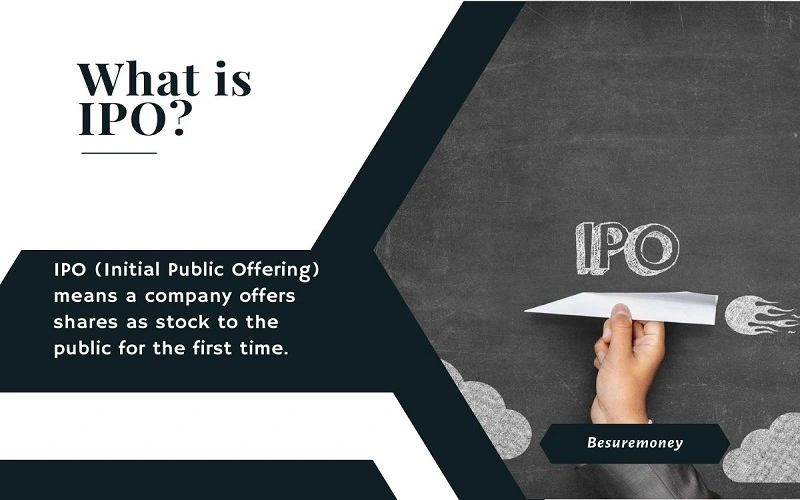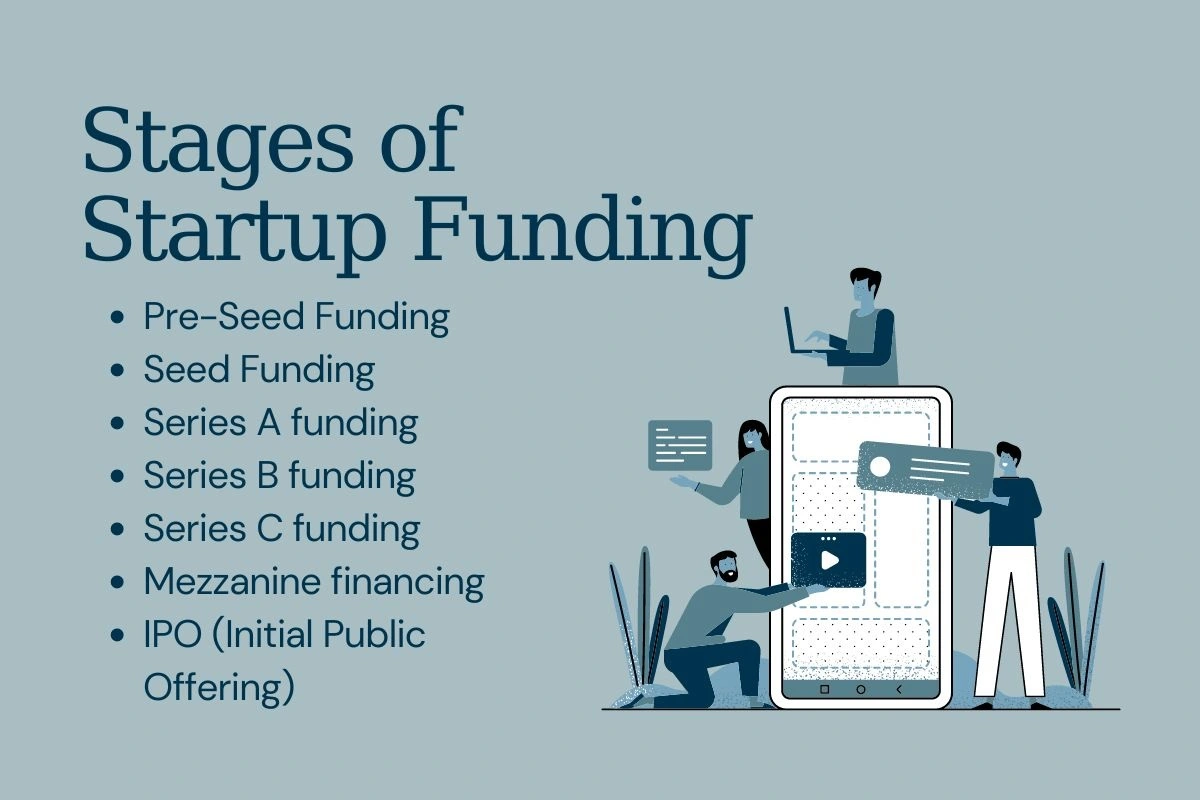In this blog, we give a full guide about startup funding stages. After reading this blog post you get full knowledge about the stages of startup funding from the initial pre-seed phase to the exhilarating moment of going public with an IPO (Initial Public Offering). We explore the specifics of each stage including the source of funding, what capital is used, and the key milestones investors look for. By this guide’s end, you’ll understand the startup funding journey and be better prepared to navigate your path to success.
What is a startup?

Startup is a new company or venture created to address a particular problem or offer a unique product or service. These businesses are created by innovation and aim to develop scalable and repeatable business models. Startups often operate in the tech industry and also in other sectors. They usually start with small resources and funding but have the potential for continuous growth and high impact. The early stages of a startup funding involve so many risks, experiments, and drives to bring fresh ideas to market.
How does startup funding work?
Startup funds go to people, big companies, the government, and groups of people to raise money for their new business which helps their company grow. When investors invest large amounts they hope to get more profit in the long term. That depends on how much investors invested in your company, so they also make business decisions that affect how the company runs.
What are the stages of startup funding?
The startup funding phase identifies different stages of startup funding strategy for investors to raise funds for growth and development. Here are the stages:
What is Pre-Seed Funding?
Pre-seed funding is a stage is your own, investing from family members and friends who believe in your business which is known as the “bootstrapping” phase is the initial phase. Entrepreneurs always looking to invest in a smaller amount ranging from $10,000 to $1 million
What the funding is used for?
Pre-seed funding is essential for laying the business foundation. Common uses include:
Market Research:
It was knowing the market target, finding customers, and analyzing competitors.
Product Development:
Development of prototype or MVP (minimum viable product) for validation and feedback.
Business Plan Development:
You make a business plan detailing the startup strategies, goals, and budget.
Initial Marketing Efforts:
Building a brand presence through a basic website, social media channels, and initial marketing activities.
What is Seed Funding?
Seed Funding is capital raised to support the early growth of startups. This funding is to move out of the prototype or MVP stage into product market fit that addresses all the feature sets required by the target customer segment. Seed funding usually falls from $100k to $2 million, with this seed round being sized up and praised on market demands for that specific startup.
Common Sources of Seed funding:
Angel investors: High net-worth individuals who provide seed investment to promising startups in return for equity. They are more helpful in mentoring and linking you up with others in the industry.
Seed Funds: Venture Capital firms or other funds focusing on early stages of startup funding. These investors’ capital and experience help them to bring significant resources capable of supporting the growth stages that startups require.
What is the purpose of seed funding?
Seed Funding: A Crucial stages of startup funding Essential for Growth and Success
Product development: To continue the growth and involve the product or service based on what you learn from your initial customers.
Market Validation: Better market research to validate the demand for your product and identify the targeted customer segments.
Creating Team: Recruiting developers, marketers, and salespeople to help the startup grow.
Marketing and sales: Initial customer acquisition campaigns to create brand visibility, and drive initial adopters.
What is Series A funding?
Series A funding is the most essential stages of startup funding to grow their business operations. Already the company has built a product, that is being trusted more, and now it wants to get more users on their platform on both sides and grow move value in properties through upgrading updates.
What are the sources of Series A funding?
Venture Capitalists (VC): Professional investors who provide a large capital investment for equity in the company. They also give us strategies and industry insight to help us grow the company.
Focus Area:
Add new feature: This is based on feedback from real users, identifying what needs to be improved and how we can grow it for a larger user base.
Growth Team: Engineer, Marketer, and Sales Team.
Market Expansion: Entering a new market and introducing new customers to expand your business.
Key metric and milestones:
User Growth: Display a growing number of the company’s active users or customers.
Revenue: Showing solid sales growth and a clear path to profitability.
Market position: Create a strong position in some targeted markets.
What is Series B funding?
Series B funding is the next level of financing that startups after achieving milestones series with Series A funding. This scale focuses on growing the business and expanding your business market reach.
Source of Series B funding:
Private Equity firms: Companies that invest their larger sums of money to help businesses expand and improve all business operations.
What is Series C funding?
Series C funding is where things get serious. At this stage, your startup has demonstrated its competence in the market and is ready to grow further. This is all about expansion you can conquer new markets, introduce new products to the local ones, or even purchase other startups.
Potential Sources of Series C Funding:
Banks and Financial Institutions: Traditional lenders are ready to provide companies with a loan or credit line.
What are the goals of Series C funding?
Expansion: At this stage, you can enter new markets, launch new products, or increase your market share.
Acquisition: You can buy other companies that could help you better achieve your goals.
Preparing for IPO: Getting ready to become a public company. By the time you get public, you have to ensure your financial health and position in your market is strong.
What is mezzanine financing?
Mezzanine Financing is a combination of debt and equity, and it often comes into play when a startup is about to grow or an important event such as acquisition. The company offers funding in exchange for the loan, with interest payments and possible equity if converted.
When used:
- To fund rapid expansion or a major project.
- Before a big funding round or IPO have cash flow management.
Advantages:
Quick access to capital
- Flexible repayment terms.
Risk:
High interest rates
- Potential loss of equity if the loan converts to stock.
What is an IPO in the stages of startup funding?

IPO (Initial Public Offering) means a company offers shares as stock to the public for the first time. This represents a milestone transition from private to public company status.
Process of IPO:
The company hires investment banks to underwrite their IPO.
Regulators require the company to file a prospectus.
Institutional and retail investors are invited to subscribe to the shares.
Benefits:
Raise significant capital
Showcasing company visibility and credibility.
Liquidity to early investors and employees.
Challenges:
It is a costly and time-consuming process.
Heightened regulatory oversight.
Short-term profitability and regulatory deadlines.
Conclusion:
Every entrepreneur has to understand the different stages of startup funding. The first idea to post-IPO, and every step along the way. Understanding what capital will be available in which stage of business and how can you position yourself best, means that your startup will secure the right type of money at each stage; as a result, it grows savvily. It is all about meticulous planning and making efficient only smarter money moves when you are going to be walking this path of the Earth for long.
FAQs:
Q1. What is the golden rule of startup?
Ans: The golden rule of startup is to find a real problem you solve and get paid and create value. And if you build something that solves their problem, your startup is way more likely to be successful. And keep in mind that only clients and how you help them matter.
Q2. What is the 10x rule for startups?
Ans: For startups, it is the 10x rule means to make your product /services at least ten times better on any feature than that of existing competition. This in turn inspires startups to dream, ideas, and deliver something extraordinary that can create an identity of its own. The goal is to be so much better that customers are compelled to create a pull for your product.
Q3. What is the 40-40 rule for startups?
Ans: There is the 40-40 rule for startups, which states that 40% of a startup’s resources(time, money, and human effort) should be spent on product development, while other surprising (or not so much ) remaining share will go to marketing & sales. The beneficiary has 20% for other items such as operations, and administration.
Q4. Is 30% a good EBITDA margin?
Ans: Yes, A 30% EBITDA Margin implies the company does a tremendous job of converting its revenue into earnings before interest, taxes, depreciation, and amortization.
